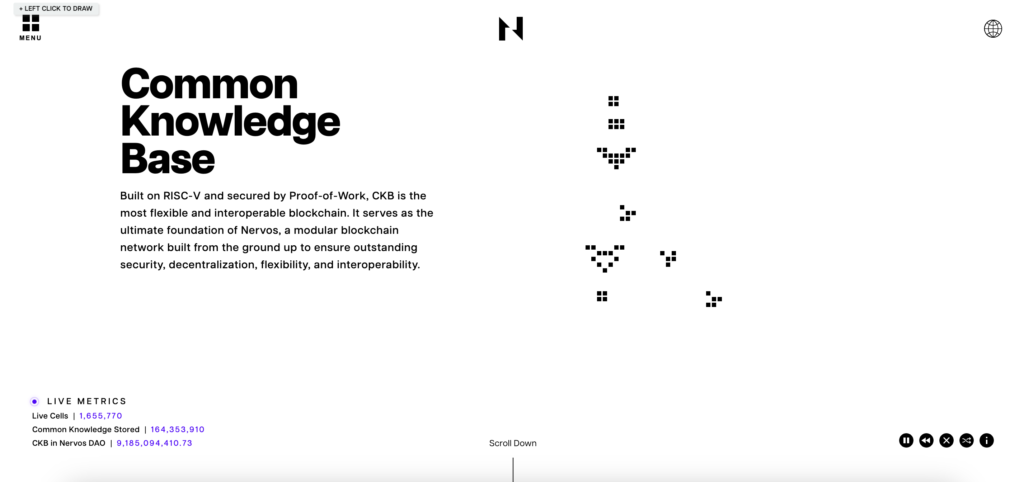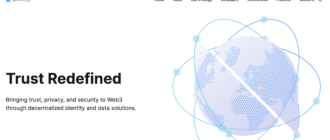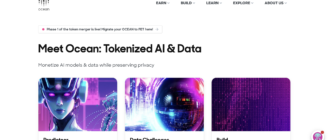In this article, we will delve into the Nervos Network, a blockchain project renowned for its unique technological approach and robust ecosystem. We’ll explore the intricacies of its architecture, the innovative tokenomics that underpin its operations, and the broader ecosystem that supports its growth. Our goal is to provide a comprehensive understanding of what Nervos Network offers, how it differentiates itself in the crowded blockchain space, and the potential future developments that could shape its trajectory.

What is Nervos Network?
Nervos Network is a multi-layer blockchain ecosystem designed to solve the scalability, interoperability, and security challenges inherent in existing blockchain platforms. At its core is the Common Knowledge Base (CKB), a unique Layer 1 blockchain that utilizes a novel cell-based architecture to optimize data storage and management. The CKB serves as a trust root, enabling secure and efficient interactions across multiple Layer 2 solutions and external blockchains. By combining a state-of-the-art Proof-of-Work consensus mechanism with a highly modular and flexible framework, Nervos aims to create a sustainable and inclusive ecosystem that supports a wide range of decentralized applications (dApps) and digital assets. This design ensures unparalleled security, seamless interoperability, and efficient scalability, positioning Nervos as a leading infrastructure for the decentralized web.
History of Nervos Network
Nervos Network was launched in 2018, aiming to address critical issues in blockchain technology such as scalability and interoperability. Key milestones in its development include:
- 2018: Launch of the Nervos project with a vision to create a modular blockchain network.
- 2019: Release of the Common Knowledge Base (CKB) mainnet, the foundational layer of the Nervos Network, designed to offer high security and decentralization through a Proof-of-Work consensus mechanism.
- 2020: Introduction of the NervosDAO, allowing users to lock CKB tokens and earn rewards, mitigating inflation and supporting the network’s economic model.
- 2021: Launch of Godwoken, an Ethereum-compatible Layer 2 solution on Nervos, enhancing interoperability and enabling developers to port Ethereum dApps seamlessly.
- 2022: Development of various partnerships and integrations, including the launch of Force Bridge, a cross-chain bridge to enhance connectivity with other major blockchains like Ethereum and BNB Smart Chain.
- 2023: Continued expansion of the ecosystem with new projects and applications building on Nervos, solidifying its role as a versatile and scalable blockchain platform.
Throughout its history, Nervos Network has consistently focused on improving blockchain technology’s core aspects, emphasizing security, flexibility, and scalability.
How Nervos Network Works
Nervos Network is architected using a combination of innovative technologies designed to address the scalability, interoperability, and security challenges faced by existing blockchain platforms. The foundational technology underpinning Nervos is the Common Knowledge Base (CKB), a unique Layer 1 blockchain that employs a cell-based architecture. This architecture draws from both the UTXO (Unspent Transaction Output) model of Bitcoin and the account model of Ethereum, combining their strengths to create a more flexible and scalable system.
Key Technologies and Their Roles
- Cell Model: The CKB uses a cell-based architecture where data is stored in “cells.” Each cell can be programmed and used for various types of data storage, similar to how UTXOs work in Bitcoin but with enhanced flexibility. This model allows for better scalability and parallel processing of transactions, addressing the limitations of both UTXO and account-based models.
- RISC-V Based Virtual Machine (CKB-VM): The Nervos CKB utilizes the RISC-V instruction set for its virtual machine, enabling low-level, hardware-like performance. This choice provides unprecedented flexibility, allowing developers to use any programming language and cryptographic primitive, making it easier to build and deploy complex dApps and smart contracts.
- Proof-of-Work (PoW) Consensus: Nervos employs a PoW consensus mechanism, leveraging the Eaglesong hashing algorithm. This ensures a high level of security and decentralization, making the network resistant to various attack vectors. Unlike many modern blockchains that have moved to Proof-of-Stake (PoS), Nervos maintains PoW for its security benefits and robust economic incentives.
Distinguishing Features
Nervos differentiates itself from other blockchain projects through its modular and flexible approach. Unlike monolithic blockchain designs, Nervos’s layered architecture allows for multiple Layer 2 solutions to operate on top of the CKB. This modularity ensures that each layer can evolve independently without affecting the core security and decentralization of the base layer.
Blockchain Structure
- Common Knowledge Base (CKB): The CKB is designed as a base layer that provides ultimate security and decentralization. It stores value and acts as a trust anchor for Layer 2 scaling solutions and cross-chain interoperability.
- Layer 2 Solutions: Nervos supports various Layer 2 solutions such as Godwoken, which is an Ethereum-compatible Rollup framework, allowing for high throughput and low-cost transactions while benefiting from the security of the CKB layer.
Consensus Mechanism
- Eaglesong Hash Function: The PoW consensus utilizes the Eaglesong hash function, which is optimized for security and efficiency. This choice ensures that the network remains secure against 51% attacks and other common blockchain vulnerabilities.
- Miner Incentives: Miners are rewarded through a combination of primary and secondary issuance of CKB tokens. The primary issuance follows a halving schedule similar to Bitcoin, while the secondary issuance introduces the concept of “state rent” to ensure long-term sustainability and incentivize miners to maintain network security.
Advanced Features
- Interoperability: Nervos’s architecture supports seamless interoperability with other blockchains. The Force Bridge, for example, allows assets to move freely between Nervos and other major blockchains like Ethereum and BNB Smart Chain.
- Scalability: By employing a modular design, Nervos can scale horizontally through the addition of Layer 2 networks. This design ensures that the network can handle a large number of transactions without compromising on security or decentralization.
Nervos Network’s innovative use of the cell model, RISC-V virtual machine, and PoW consensus provides a robust, flexible, and scalable blockchain solution. This combination of technologies positions Nervos as a unique and forward-thinking platform in the blockchain space.
Tokenomics of Nervos Network
Nervos Network features the native cryptocurrency CKByte (CKB), which functions as a coin rather than a token. CKB plays a fundamental role in the Nervos ecosystem, facilitating transaction fees, data storage, and acting as an incentive mechanism for miners.
Emission Model
CKB was launched with an initial supply of 33.6 billion coins. Notably, 8.4 billion of these were burned shortly after the launch to stabilize the supply. The emission model of CKB consists of both primary and secondary issuances:
- Primary Issuance: This initial supply is designed to decrease over time, halving every four years until it reaches zero, similar to Bitcoin’s halving model.
- Secondary Issuance: An ongoing issuance of 1.344 billion CKB per year exists to compensate for state storage and network security. This mechanism ensures that miners continue to receive incentives even as the primary issuance diminishes.
The unique state rent model ties the issuance to the amount of blockchain state occupied. Miners receive rewards from both the primary and secondary issuances, ensuring long-term network security and economic sustainability.
Price and Market Dynamics
As of recent data, the price of CKB fluctuates within a range typical for emerging cryptocurrencies. The price reflects market sentiment, adoption rates, and the overall health of the cryptocurrency market. CKB’s market cap and liquidity are growing steadily, with a total supply currently around 34.78 billion coins in circulation. This supply is dynamic and will continue to evolve based on the tokenomics model, particularly the halving events and ongoing secondary issuance.
Unique Economic Incentives
The NervosDAO smart contract offers a unique feature for long-term holders of CKB. Users can lock their CKB in the NervosDAO to earn rewards, which serves as an inflation shelter. This mechanism aligns the interests of long-term investors with the health and security of the network, encouraging sustained engagement and reducing the inflationary impact of the secondary issuance.
Distinguishing Features
Nervos’ tokenomics are designed to address several key issues in blockchain economics:
- State Rent Model: By linking state occupation with secondary issuance, Nervos incentivizes efficient use of blockchain space, preventing state bloat and ensuring sustainable network growth.
- Incentive Alignment: The model ensures that miners and network participants are continuously incentivized, even as primary issuance decreases, fostering long-term security and stability.
- Inflation Protection: Through the NervosDAO, CKB holders can mitigate the effects of inflation, preserving the value of their holdings while contributing to network security.
Nervos Network’s approach to tokenomics is innovative, providing a robust economic foundation that balances incentives for miners, developers, and long-term holders. This comprehensive model ensures that the network remains secure, scalable, and sustainable in the long run.
Where to Buy CKB
CKByte (CKB) can be purchased on several major cryptocurrency exchanges. Here are some of the prominent platforms where CKB is actively traded:
- Binance: One of the largest and most popular cryptocurrency exchanges in the world, offering a wide variety of trading pairs for CKB.
- HTX (formerly Huobi): A major exchange that supports CKB trading with high liquidity and various trading pairs.
- MEXC: Known for its diverse selection of cryptocurrencies, MEXC provides good liquidity and competitive trading fees for CKB.
- Gate.io: Primarily a derivatives exchange, Gate.io also offers spot trading for CKB, catering to a wide range of traders.
- KuCoin: A user-friendly exchange that offers extensive support for CKB with a variety of trading pairs and robust security measures.
When choosing an exchange, consider factors such as trading fees, security features, liquidity, and user experience.
Where to Store CKByte (CKB)
After purchasing CKByte (CKB), it is essential to store it securely. Here are some recommended wallets that support CKB storage:
- Neuron Wallet: The official wallet developed by the Nervos team, providing full node capabilities, secure storage, and seamless integration with the Nervos Network.
- Ledger Nano S/X: Hardware wallets known for their high security, supporting CKB through integration with Neuron Wallet. Ideal for long-term storage and protection against online threats.
- CKBull Wallet: A mobile wallet that offers user-friendly access to CKB storage and transactions, suitable for everyday use and small to medium holdings.
- ImToken: A widely used mobile wallet that supports multiple cryptocurrencies, including CKB. Known for its intuitive interface and secure storage options.
- SafePal: Another hardware wallet option that supports CKB, combining security and ease of use with its mobile application integration.
When selecting a wallet, consider your specific needs, such as ease of use, security features, and whether you prefer a hardware or software solution. For large holdings, hardware wallets are generally recommended due to their enhanced security.
Project Prospects
Nervos Network’s growth prospects are underpinned by its innovative technology, strategic partnerships, and expanding ecosystem. The project’s growth is driven by several key factors:
Foundation for Growth
- Technological Innovation: Nervos Network’s unique cell model, RISC-V based virtual machine, and Proof-of-Work consensus provide a strong technological foundation that supports high security, flexibility, and scalability. This robust infrastructure attracts developers and projects seeking to leverage advanced blockchain technology.
- Interoperability and Flexibility: By enabling seamless interoperability with other blockchains through solutions like Force Bridge, Nervos Network positions itself as a crucial player in the multi-chain ecosystem. This capability attracts projects looking for cross-chain compatibility and broadens the potential user base.
- Scalability Solutions: Nervos’s modular architecture supports multiple Layer 2 solutions, ensuring that the network can scale effectively without compromising security. This makes it an attractive platform for high-throughput applications and enterprise adoption.
Clients and Partners
Nervos Network collaborates with a range of partners and serves a diverse set of clients, including blockchain developers, enterprises, and decentralized application projects. Notable partners and collaborations include:
- China Merchants Bank International: Partnering to explore blockchain solutions in finance.
- IMToken: Integration to support CKB within their popular wallet application.
- Ethereum and BNB Smart Chain: Via Force Bridge for cross-chain asset transfers.
- Cardano: Working together on cross-chain research and development.
- Blockchain-Based Service Network (BSN): Integrating Nervos into this Chinese government-backed initiative to provide blockchain services globally.
These partnerships enhance Nervos’s credibility and provide avenues for extensive real-world applications.
Ecosystem
Nervos Network boasts a thriving ecosystem composed of various projects, tools, and communities that contribute to its growth and adoption. Key components of the Nervos ecosystem include:
- Godwoken: An Ethereum-compatible Layer 2 solution that enhances scalability and interoperability.
- Axon: A customizable sidechain framework designed to meet specific application needs.
- NervosDAO: A smart contract providing an inflation shelter for long-term CKB holders, encouraging network participation.
- CKB Studio and Neuron Wallet: Tools designed to facilitate development and secure storage within the Nervos ecosystem.
Future Outlook
The future of Nervos Network looks promising due to its commitment to continuous innovation and expansion. The project’s roadmap includes further enhancements in scalability, interoperability, and security. As blockchain technology continues to gain mainstream adoption, Nervos Network’s foundational strengths position it well to attract a broad range of users and applications. The network’s ability to evolve and integrate with other major blockchains will likely drive its adoption and utility in the decentralized web.
Conclusion
The Nervos Network stands out with its modular design, unique consensus mechanisms, and forward-thinking tokenomics. Its commitment to security, flexibility, and interoperability positions it as a formidable player in the blockchain landscape. As the ecosystem continues to evolve, Nervos Network’s innovative approach could play a pivotal role in the future of decentralized technologies. Through this article, we have aimed to shed light on the core aspects of the project, providing insights into its current status and future potential.






